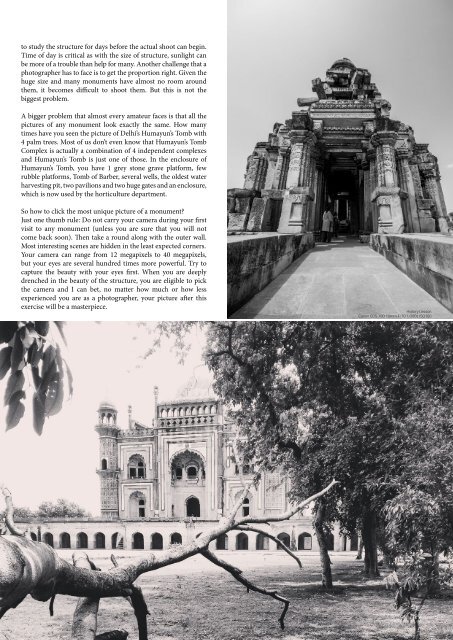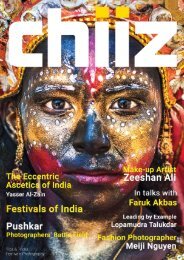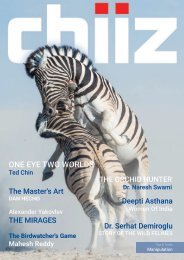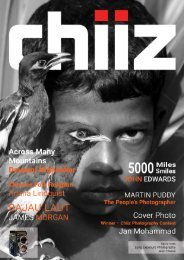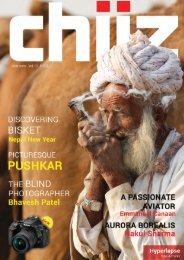Chiiz Volume 10 : Black and White Photography
There is no doubt that colors bring out the vivaciousness of a picture but this time we are all geared to floor you with the magic of monochrome. This time Chiiz has brought to you a special edition based on Black and White Photography. Marc Henauer is here take you to a trip the world under the deep dark sea, the beauty of monochrome is explained by Ravi Dhingra in “Frozen in time”, Urshita Saini and Donatella Nicolini delves us into a relatively new genre of photography, i.e. Maternity and Birth Photography. The retention of the culture of Iran in the face of modernization is depicted amazingly by Duncan Chard. Mehdi Nazeri’s work on the pigeon fanciers in ‘The Birds of Hope’ is truly commendable and Debrani Das creates magic with her series on ‘Levitating Lovers, Unspoken Love’. Ashok Ghosh’s Work is a sight for sore eyes and is bound to leave you in awe and admiration for the ingenious photographer. Vikramjit Roop Rai covers the heritage of India and Shares ‘Why and How to Shoot Monuments’. Aman Chotani’s work on lights, lines and textures is replete with interesting elements that will leave you wanting for more. Turn the pages and find a lot more incredible stories in this volume.
There is no doubt that colors bring out the vivaciousness of a picture but this time we are all geared to floor you with the magic of monochrome.
This time Chiiz has brought to you a special edition based on Black and White Photography. Marc Henauer is here take you to a trip the world under the deep dark sea, the beauty of monochrome is explained by Ravi Dhingra in “Frozen in time”, Urshita Saini and Donatella Nicolini delves us into a relatively new genre of photography, i.e. Maternity and Birth Photography. The retention of the culture of Iran in the face of modernization is depicted amazingly by Duncan Chard. Mehdi Nazeri’s work on the pigeon fanciers in ‘The Birds of Hope’ is truly commendable and Debrani Das creates magic with her series on ‘Levitating Lovers, Unspoken Love’. Ashok Ghosh’s Work is a sight for sore eyes and is bound to leave you in awe and admiration for the ingenious photographer. Vikramjit Roop Rai covers the heritage of India and Shares ‘Why and How to Shoot Monuments’. Aman Chotani’s work on lights, lines and textures is replete with interesting elements that will leave you wanting for more. Turn the pages and find a lot more incredible stories in this volume.
You also want an ePaper? Increase the reach of your titles
YUMPU automatically turns print PDFs into web optimized ePapers that Google loves.
to study the structure for days before the actual shoot can begin.<br />
Time of day is critical as with the size of structure, sunlight can<br />
be more of a trouble than help for many. Another challenge that a<br />
photographer has to face is to get the proportion right. Given the<br />
huge size <strong>and</strong> many monuments have almost no room around<br />
them, it becomes difficult to shoot them. But this is not the<br />
biggest problem.<br />
A bigger problem that almost every amateur faces is that all the<br />
pictures of any monument look exactly the same. How many<br />
times have you seen the picture of Delhi’s Humayun’s Tomb with<br />
4 palm trees. Most of us don’t even know that Humayun’s Tomb<br />
Complex is actually a combination of 4 independent complexes<br />
<strong>and</strong> Humayun’s Tomb is just one of those. In the enclosure of<br />
Humayun’s Tomb, you have 1 grey stone grave platform, few<br />
rubble platforms, Tomb of Barber, several wells, the oldest water<br />
harvesting pit, two pavilions <strong>and</strong> two huge gates <strong>and</strong> an enclosure,<br />
which is now used by the horticulture department.<br />
So how to click the most unique picture of a monument?<br />
Just one thumb rule: Do not carry your camera during your first<br />
visit to any monument (unless you are sure that you will not<br />
come back soon). Then take a round along with the outer wall.<br />
Most interesting scenes are hidden in the least expected corners.<br />
Your camera can range from 12 megapixels to 40 megapixels,<br />
but your eyes are several hundred times more powerful. Try to<br />
capture the beauty with your eyes first. When you are deeply<br />
drenched in the beauty of the structure, you are eligible to pick<br />
the camera <strong>and</strong> I can bet, no matter how much or how less<br />
experienced you are as a photographer, your picture after this<br />
exercise will be a masterpiece.<br />
History Lesson<br />
Canon EOS 70D <strong>10</strong>mm F/<strong>10</strong> 1/200s ISO<strong>10</strong>0<br />
The Monuments<br />
Canon EOS 500D 22mm F/3.5 1/500s ISO200


